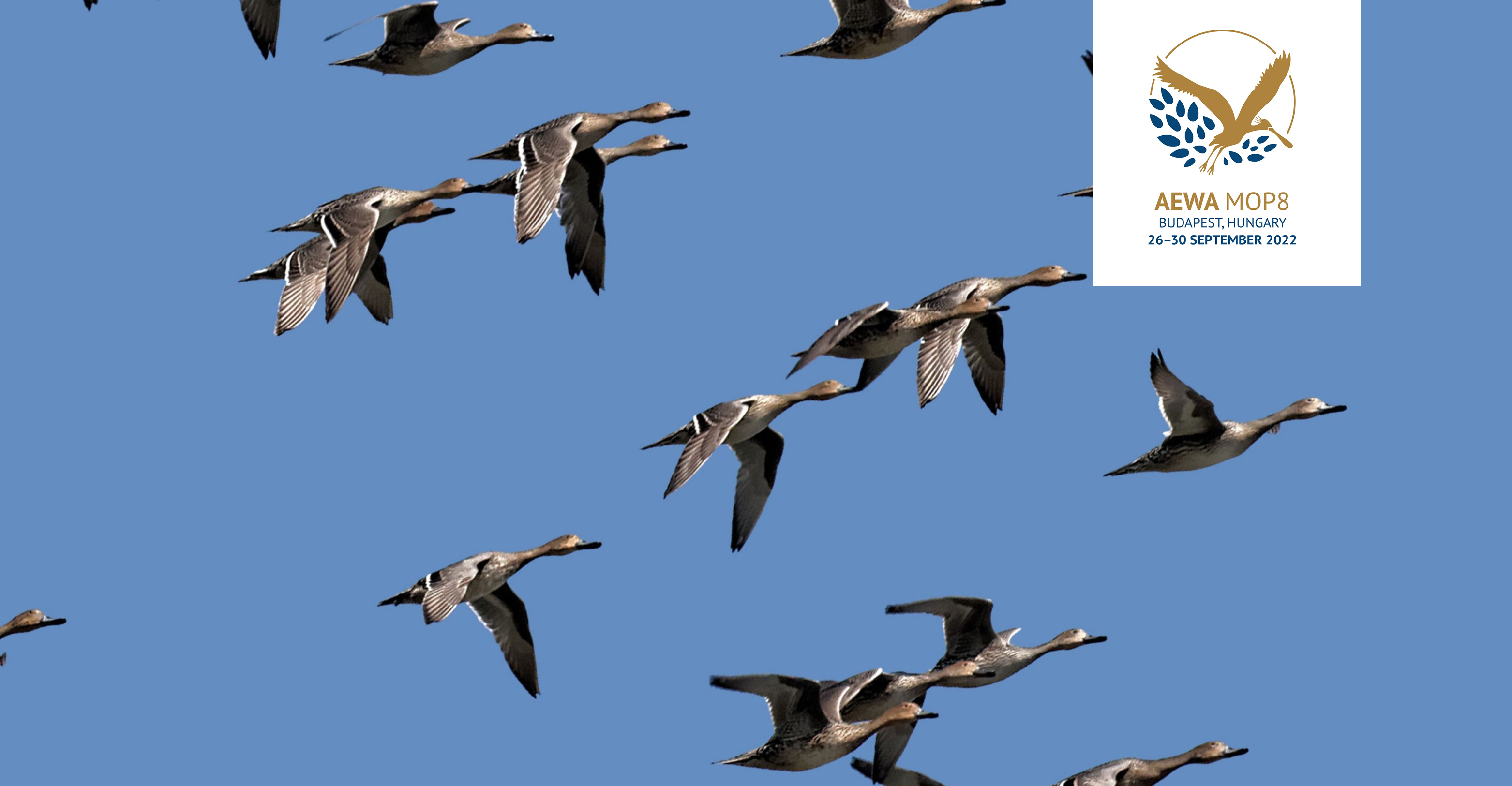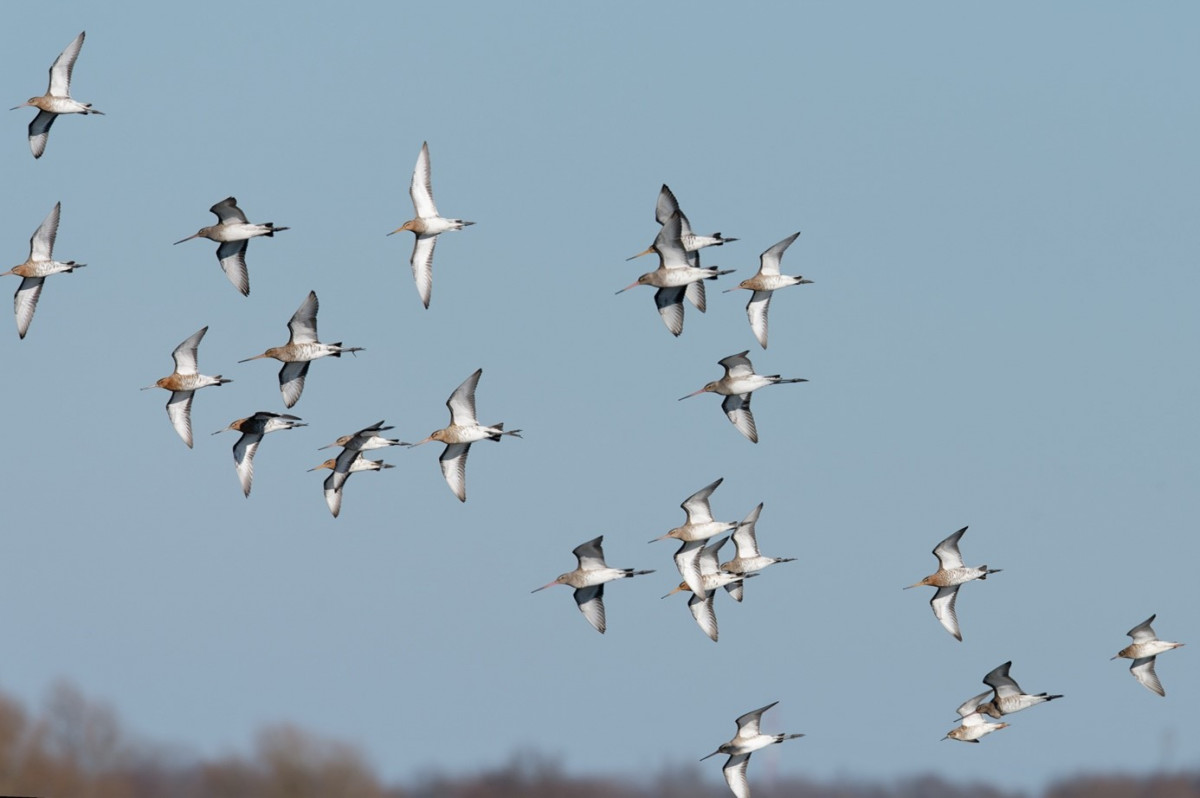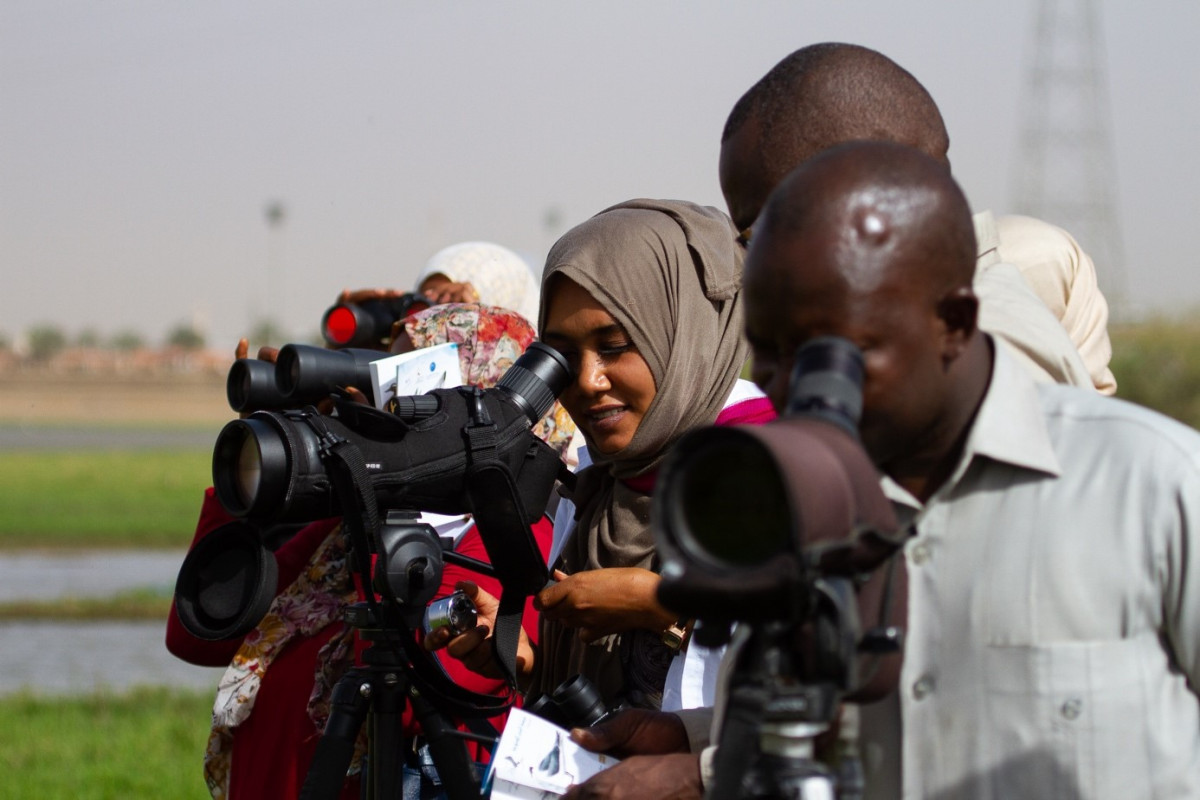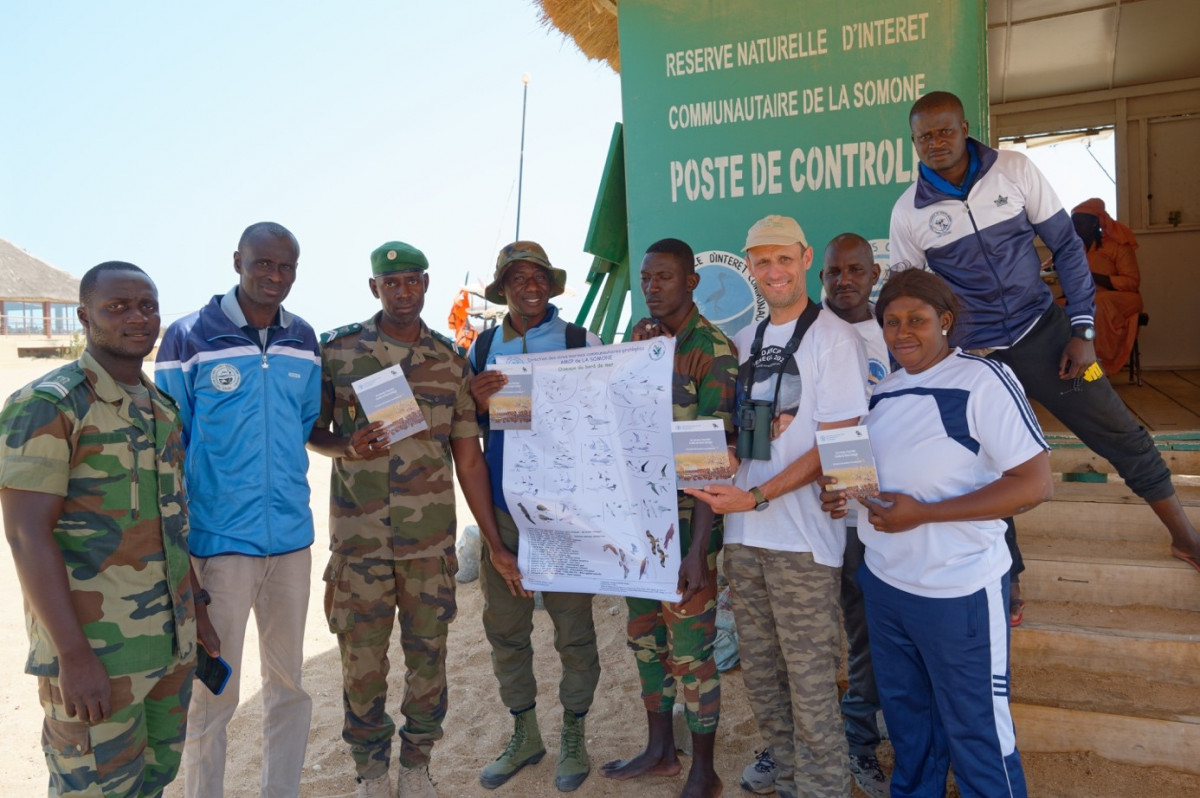Successful Collaboration with AEWA: RESSOURCE Project to Sustain Achievements in the Sahel Region

Pintails in flight © Canva.com
Article contributed by the Coordination Unit of the FAO RESSOURCE Project for AEWA MOP8
Bonn, 21 September 2022 - Today, millions of people in the Sahel continue to depend on wetlands and waterbirds for their income, food and cultural identity. These rich ecosystems provide essential services to local communities: Sahelian wetlands are the site of important economic, agricultural and pastoral activities, helping to sustain the livelihoods of millions of people.
These wetlands store carbon, retain most freshwater and improve its quality. They are also home to a rich biodiversity, in particular millions of waterbirds, including many Palearctic migrants, but also many Afro-tropical species that are sedentary or migratory according to seasonal rainfall variations.
However, climate change, hydro-agricultural development and intensive exploitation of natural resources threaten these fragile habitats. A dramatic decline of up to 40 percent in waterbird populations was recorded in the region between 1960 and 2000. If waterbirds were to disappear from this region, many rural communities would be deprived of a valuable source of protein, and the balance of these wetlands would be threatened.
It is therefore essential that wetlands and waterbird populations are managed in a sustainable way.

© FAO/Bruno Portier
The Agreement on the Conservation of African-Eurasian Migratory Waterbirds (AEWA), concluded on 16 June 1995 in The Hague, brings together countries and the wider international conservation community in an effort to establish coordinated conservation and management of migratory waterbirds throughout their entire migratory range. From the Siberian tundra in the arctic circle to the southern tip of the African continent, AEWA spans 119 countries – representing more than half of the world’s countries – and protects 560 populations of majestic waterbird and seabird species such as the white Stork, the Shoebill, the African Penguin, and the Grey Crowned Crane.
From 26-30 September 2022 in Budapest, Hungary, the 8th Session of the Meeting of the Parties to AEWA (MOP8) gathers the full range of AEWA Contracting Parties and partners including representatives of other international treaties, international and national non-governmental organizations as well as experts from the scientific community.
The official slogan of MOP8 – Strengthening Flyway Conservation in a Changing World – captures the need for AEWA Parties to use this MOP and make collective decisions to ensure stronger resources for the implementation and the delivery of the Agreement, through particularly challenging times with the pressing global issues related to climate change, biodiversity loss and shifting priorities in particular due to the impact of the COVID 19 pandemic. Strengthening flyway conservation can only materialize with sustainable funding, compliance, and increased implementation.
"The species covered by AEWA depend on favourable habitats for breeding, but also on a network of sustainably managed sites to enable them to carry out their annual migrations between breeding and wintering grounds," explains Mr. Jacques Trouvilliez, Executive Secretary of AEWA. "This is why international cooperation across their entire range, as provided by AEWA through its 82 Contracting Parties, is crucial," he added.
Launched in 2017, the RESSOURCE Project1 coordinated by the Food and Agriculture Organization of the United Nations (FAO) and co-funded by the French Global Environment Facility and the European Union, aims to address the very challenges facing rural communities, migratory birds and their habitats in Egypt, Mali, Senegal, Sudan and Chad.
The project activities, in particular support to international waterbird counts, capacity development, and strengthening of legal and institutional frameworks, directly contribute to the achievement of many of the objectives of the AEWA Action Plan for Africa (2019-2027) (PoAA 2019-2027).
Monitoring for better conservation
Regular, standardised, periodic monitoring is essential for following the resource, as the data acquired enable the overall numbers and health of the waterbird populations concerned to be tracked over time and reassessed.
Since the start of the RESOURCE Project in 2017, 20,413 records from waterbird counts have been formatted, validated and stored in a database specially developed for the project. Specifically, a total of 3,433,674 birds have been counted.
"The largest sites are sampled by aerial transects, making it possible to carry out analyses using statistical methods (distance sampling) and to obtain extrapolated abundances on the scale of areas that could never be covered otherwise," explains Clémence Deschamps, Project Manager at the Tour du Valat Research Institute.

© Hichem Azafzaf
The important work of verifying and validating monitoring data is an essential step in ensuring the reliability of the information provided to scientists, managers and policy makers. The data are made available to governments, which transmit them to Wetlands International, a partner in the RESSOURCE Project, thus contributing to the assessment of long-term waterbird population trends and to the identification of wetlands of international importance according to the Ramsar Convention criteria.
The development of national and local expertise, at the heart of the action
Converging in the same direction as the PoAA 2019-2027, which recognises the important role that local communities play in waterbird conservation, the RESSOURCE Project places particular emphasis on national and local capacity building.
"The project and its partners have trained more than 150 professionals from national administrations, NGOs and local communities on, among other things, the identification of waterbirds, counting techniques and monitoring of removals, as well as data collection and processing, and the management and conservation of Sahelian wetlands," explains Bruno Portier, Coordinator of the RESSOURCE Project at the Food and Agriculture Organization of the United Nations.
Many tools developed by the project support this transfer of skills, such as the ornithological guide Waterbirds in the Senegal River Delta - A short guide to identification and counting, as well as the guide " Invasive plant species in the Senegal River Delta - Knowing how to recognize them and intervene".

© FAO
The finalization of a MOOC entitled "Identifying and Counting North African and Sahelian Waterbirds: How and for What Purposes" is also a major step forward for the RESSOURCE Project in distance learning. This e-learning course, which will be free and open to all, is a widely accessible training tool that will enable an unlimited number of learners to acquire new skills and knowledge, and to obtain a certificate upon successful completion of the course.
This MOOC, scheduled to be launched in early 2023, will provide more than 35 hours of learning in six modules. Led by a team of international experts and trainers renowned for their expertise in the Sahel region, it will feature dozens of animations and videos, thousands of images of waterbirds and 210 'species' sheets for the identification of Sahelian waterbirds, as well as training and evaluation quizzes.
Restore and preserve wetlands
The maintenance of favourable habitats is crucial for the conservation of waterbirds and guides the joint mission of AEWA and the RESSOURCE Project.
The project is working to strengthen the protection status of wetlands. In Sudan, thanks to the collaborative work between the RESSOURCE Project, the Sudanese Wildlife Administration and local communities, the Khor Abu Habil Inland Delta has been officially designated as a Wetland of International Importance under the Ramsar Convention.

© Office français de la biodiversité/Alizé Chiappini and Camille Barbé
The project is also experimenting with the cultivation of water lilies in the Senegal River delta, an income-generating activity that respects nature, in order to restore wetlands and enhance traditional knowledge. Communities have traditionally used this wild plant as a source of food and for its therapeutic properties.
The objective is to transform abandoned rice fields into natural water bodies suitable for water lilies. "The RESSOURCE Project seeks to support the people living along the wetlands to restore these natural ecosystems where the resource will be cultivated and benefit both humans and migratory birds," explains Seydina Issa Sylla, OMPO's representative in Senegal.
The project's efforts have paid off. "Not only does the water lily nourish and heal, but it sells very well. A kilogram of water lilies has gone from 2,000 to 5,000 francs in one year (2021)," explains Fambeye Diop, a water lily farmer from the village of Débi (Senegal).
Strengthening legal and institutional frameworks
"It is through the integration into national policies of the commitments made by States that have ratified agreements on wetland and waterbird conservation, notably AEWA and Ramsar, that the efforts and achievements of the RESSOURCE project will be perpetuated" explains Mr. Trouvilliez.
In order to provide easy access to the legal arsenal of the countries where the RESSOURCE Project operates, as well as to analyses on the implementation of the Ramsar Convention and the AEWA Agreement, the team has developed and published online legal platforms (those for Mali, Chad, Sudan and Senegal are already available; the one for Egypt is being finalized). "We hope that these legal platforms will be able to better inform all interested actors and stakeholders and thus trigger participatory law reform processes," explains Eugenio Sartoretto, FAO Legal Advisor and Coordinator of the Institutional and Legal Component activities of the RESSOURCE Project.
For more information: https://swm-programme.info/fr/web/guest/ressource-project
1 The RESOURCE Project stands for "Strengthening Expertise in South Sahara on Birds and their Rational Use for Communities and their Environment". Co-funded by the French Facility for Global Environment and the European Union, the RESSOURCE Project is the Sahelian component of the Sustainable Wildlife Management (SWM) Programme, an initiative of the Organisation of African, Caribbean and Pacific States (OACPS).
Last updated on 22 September 2022


